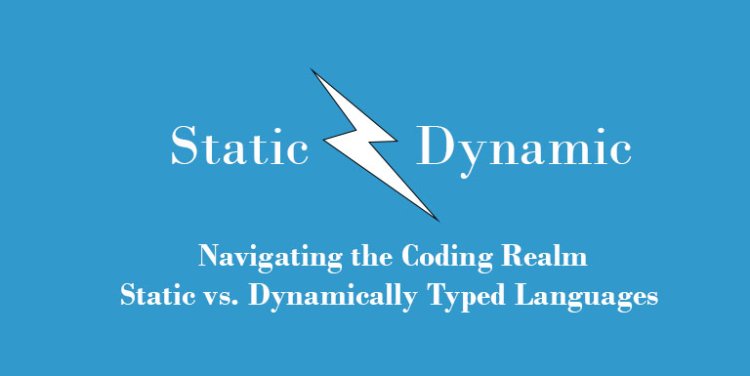Navigating the Coding Realm: Static vs. Dynamically Typed Languages

In the world of programming, the choice of programming language can be akin to selecting the right tool for a particular task. One of the fundamental distinctions that shape this choice is the typing system: static and dynamically typed languages. Each approach brings its own set of benefits and trade-offs, catering to different programming needs and developer preferences. Join us as we embark on a journey to explore the nuances of static and dynamically typed languages, unraveling their strengths, weaknesses, and real-world applications.
Static Typing: Building a Strong Foundation
Static typing refers to a programming language feature where variables are bound to a specific data type at compile time. This means that the data type of a variable is declared explicitly, and any attempts to assign a value of a different type will result in a compilation error. Here's why static typing appeals to developers:
1. Early Error Detection:
One of the primary advantages of static typing is its ability to catch errors early in the development process. By enforcing strict type checking at compile time, the likelihood of runtime errors caused by type mismatches is significantly reduced. This leads to more reliable and stable code.
2. Improved Code Readability and Documentation:
Explicitly declaring variable types enhances the readability of the codebase, making it easier for other developers to understand the purpose and usage of variables. This also results in better documentation, which aids in maintaining and extending the code over time.
3. Enhanced Performance:
Static typing can lead to optimized performance, as the compiler has a clear understanding of data types and can generate more efficient machine code. This can be crucial in resource-intensive applications where speed is a priority.
4. Stronger Tooling Support:
Static typed languages often have robust development environments and integrated development tools that leverage type information to provide intelligent code completion, refactoring suggestions, and error checking, enhancing developer productivity.
Dynamically Typed Languages: Flexibility Unleashed
In contrast, dynamically typed languages allow variables to change their data type during runtime. The data type of a variable is determined at the moment it is assigned a value. Here's a glimpse into the advantages of dynamically typed languages:
1. Rapid Development and Flexibility:
Dynamically typed languages excel in scenarios that require rapid prototyping and iteration. The absence of type declarations allows developers to quickly experiment and test ideas without the need to explicitly define data types.
2. Concise Code:
The absence of explicit type declarations leads to more concise code, as developers do not need to write out data type information repeatedly. This can result in faster coding and potentially cleaner-looking code.
3. Easy Adaptation to Changing Requirements:
In dynamic languages, variables can change their type based on the context of the program. This inherent flexibility makes it easier to adapt to changing requirements and scenarios.
4. Interactive Development and Scripting:
Dynamically typed languages are often used for scripting and interactive development, where immediate feedback and ease of use are crucial. Languages like Python and JavaScript are popular choices in this context.
Making the Choice: Context is Key
Ultimately, the decision between static and dynamically typed languages depends on the nature of the project, the development team's preferences, and the desired trade-offs between performance, error prevention, and development speed. Static typing offers robustness and error detection, while dynamic typing offers flexibility and rapid development. Thankfully, the vast landscape of programming languages caters to both paradigms, ensuring that developers have the tools they need to bring their visions to life.
As you embark on your coding journey, remember that both static and dynamically typed languages have their merits, and the right choice hinges on understanding your project's requirements and aligning them with the strengths of each approach. Whether you're building robust enterprise applications or experimenting with innovative ideas, the world of programming languages has a realm waiting to be explored, shaped by your creativity and goals.
What's Your Reaction?















